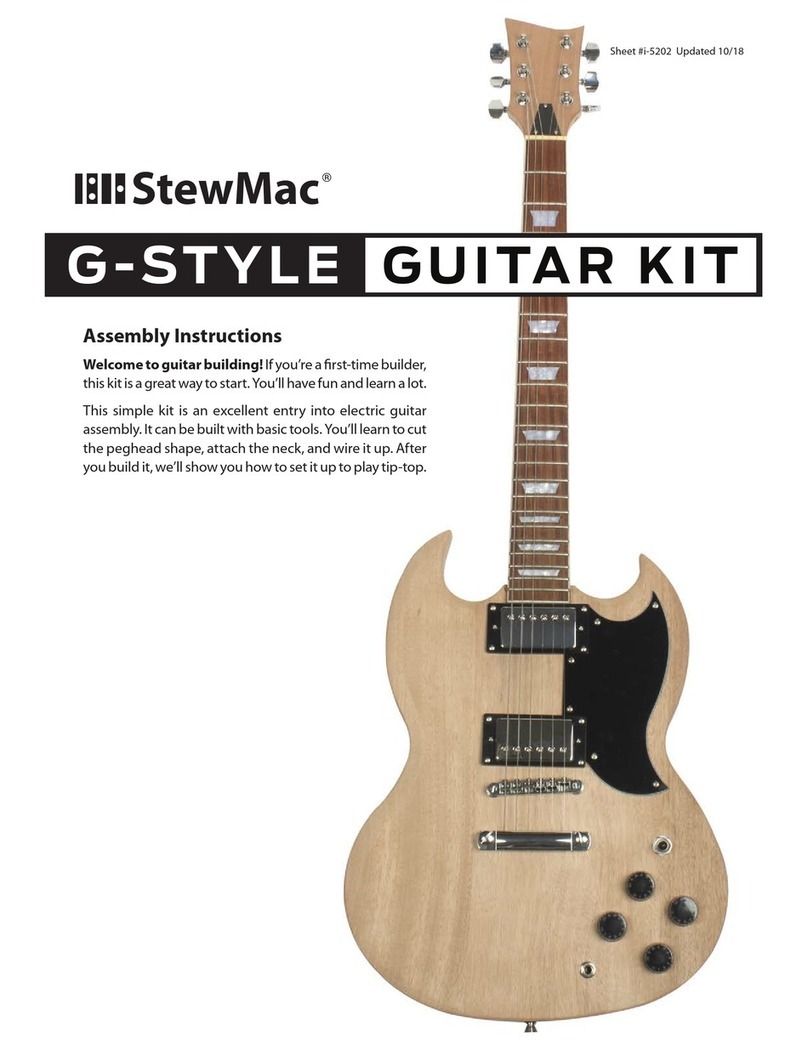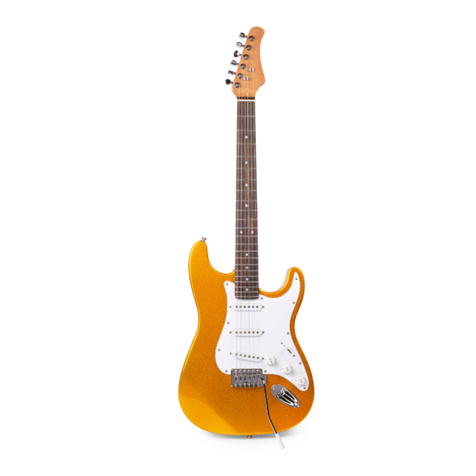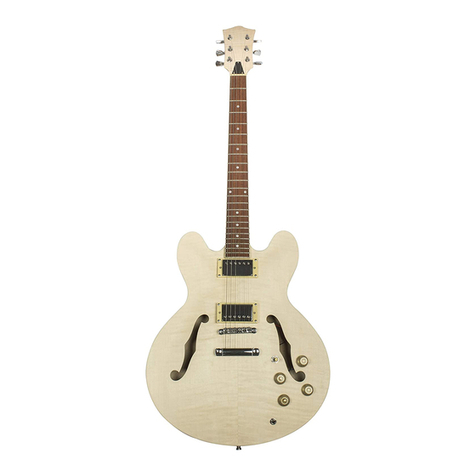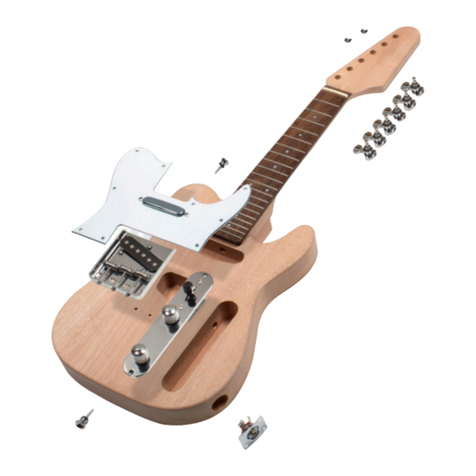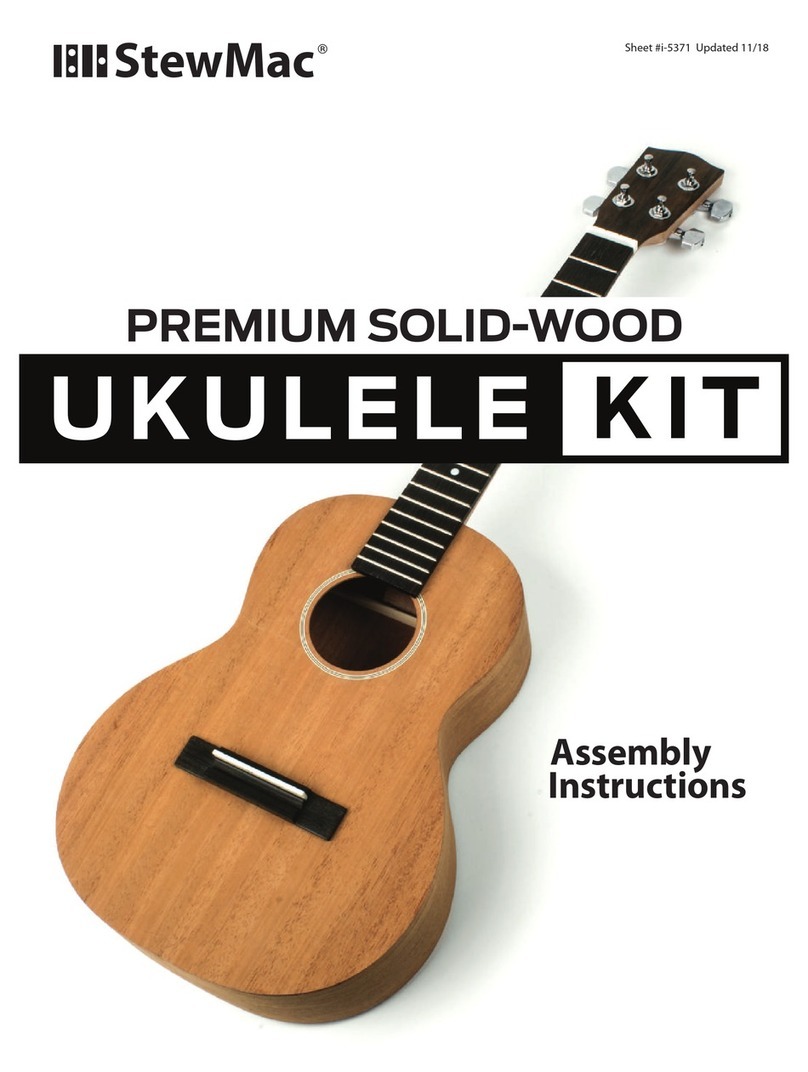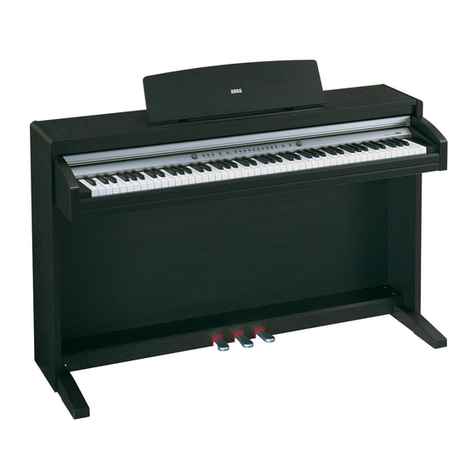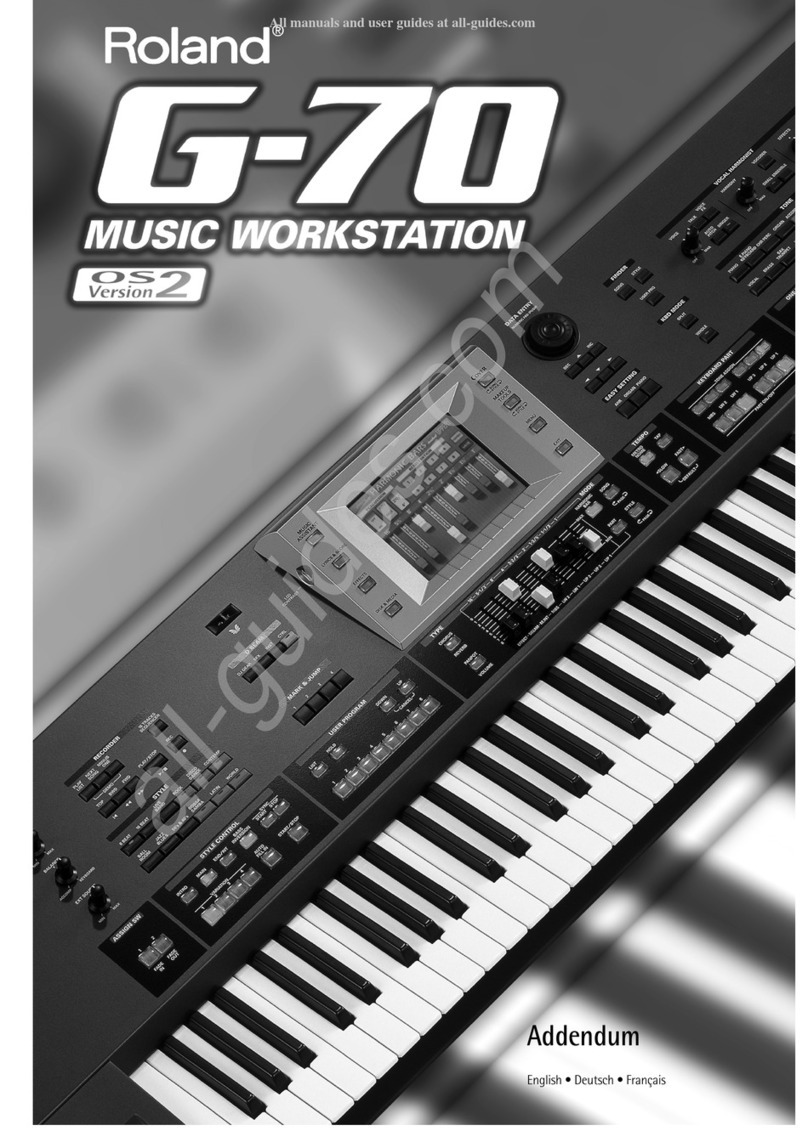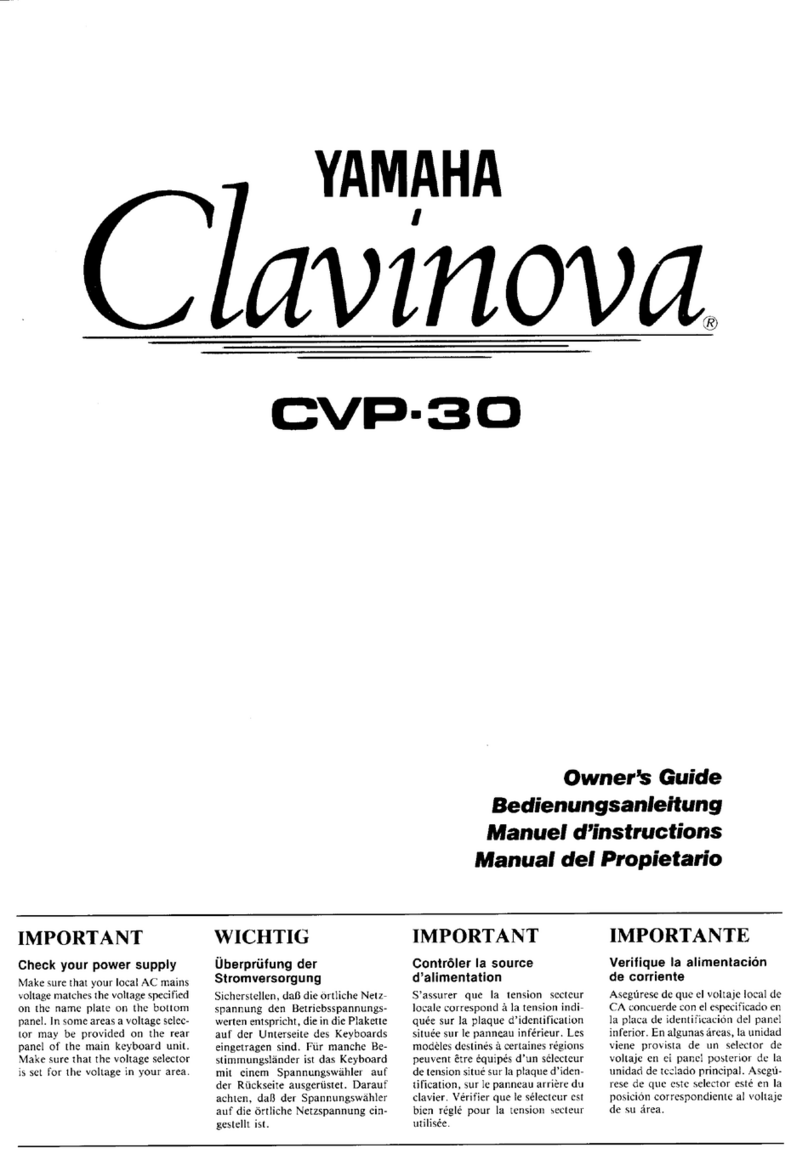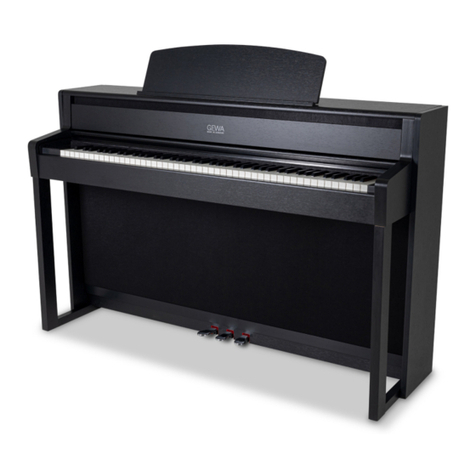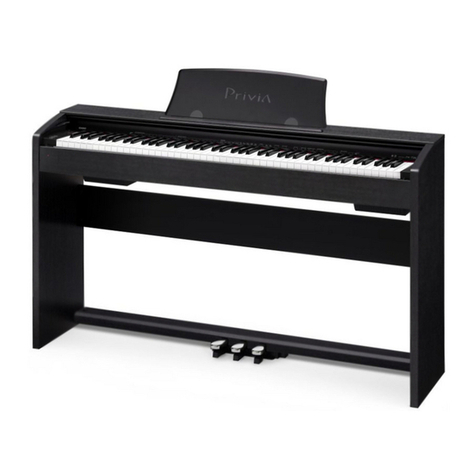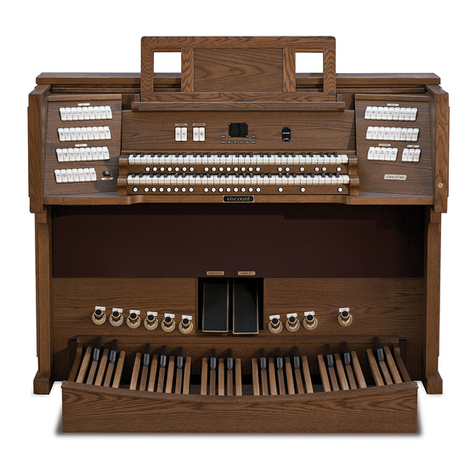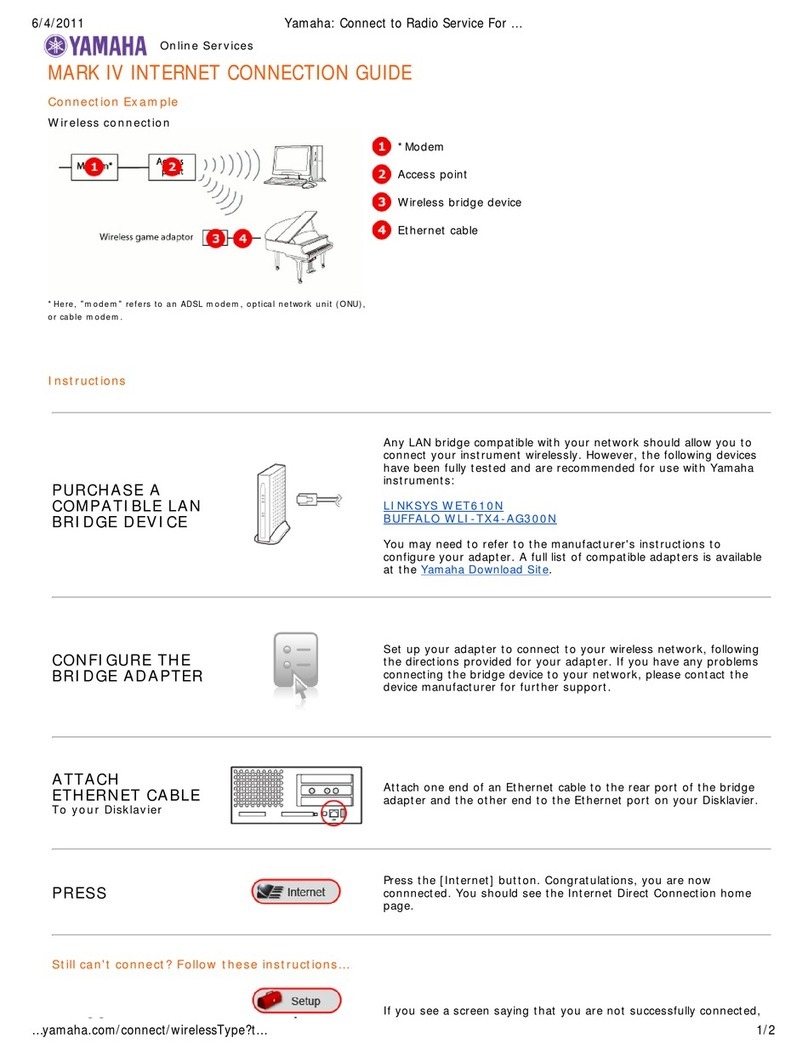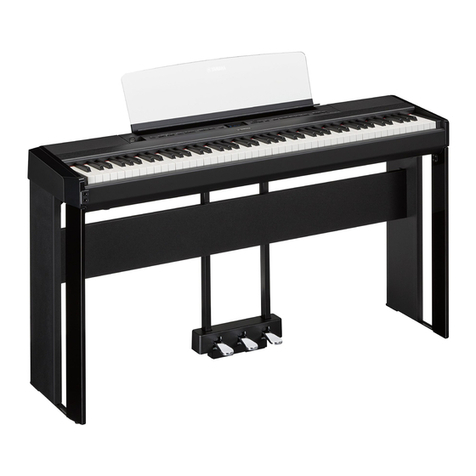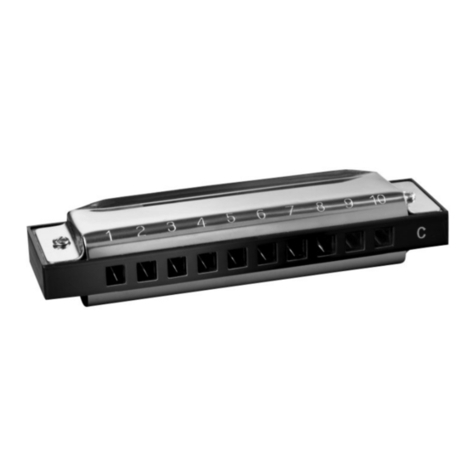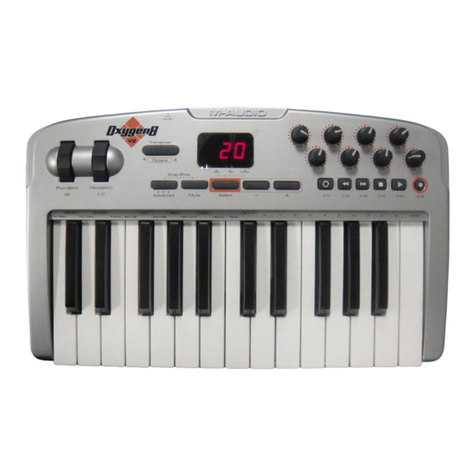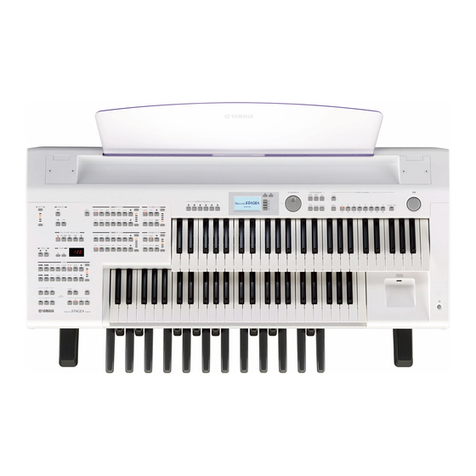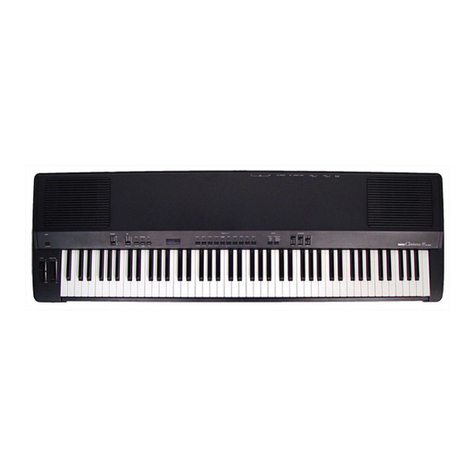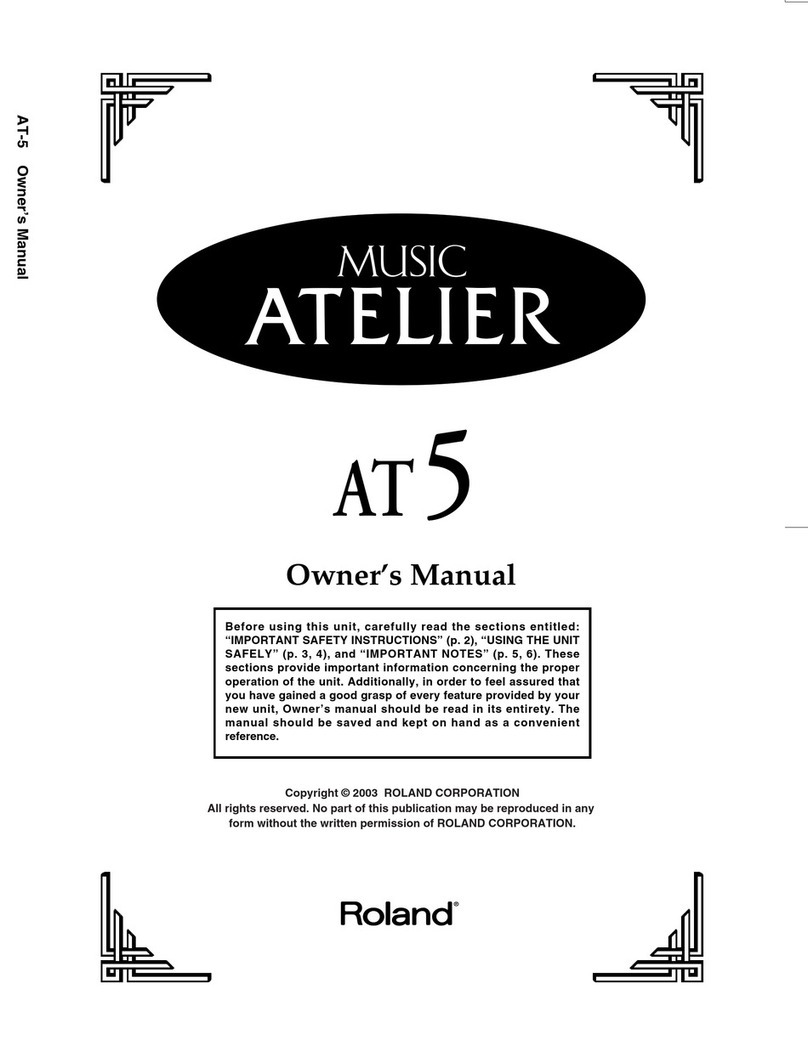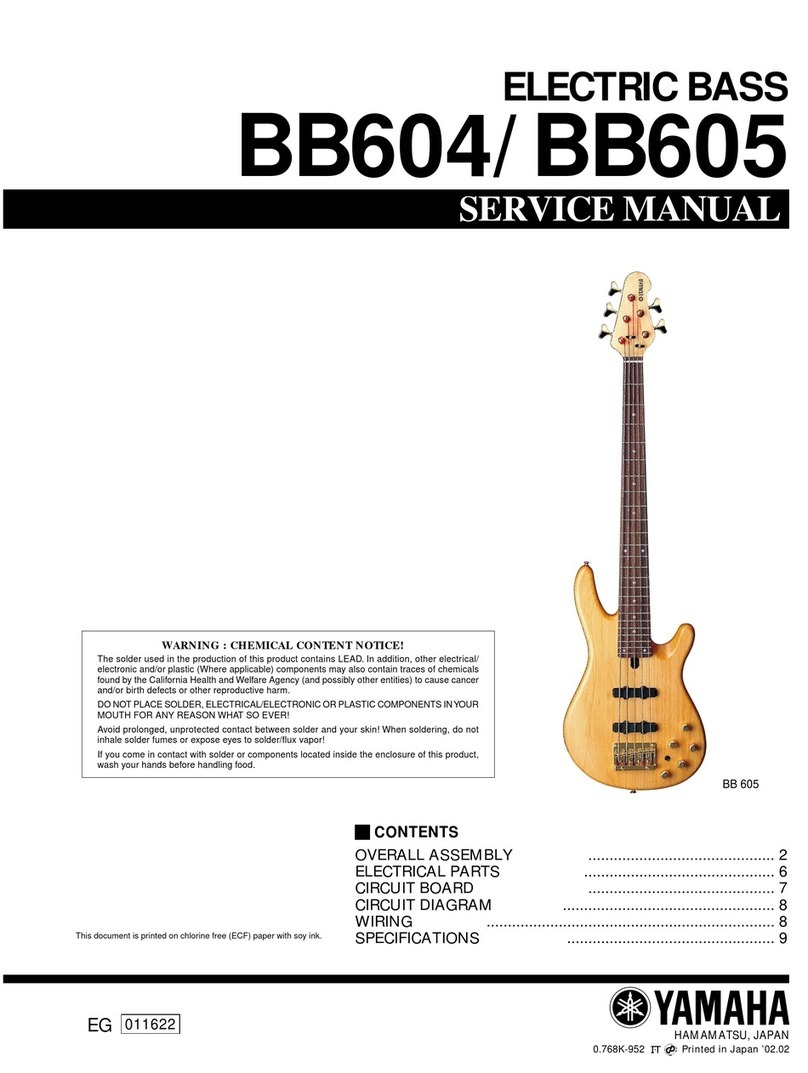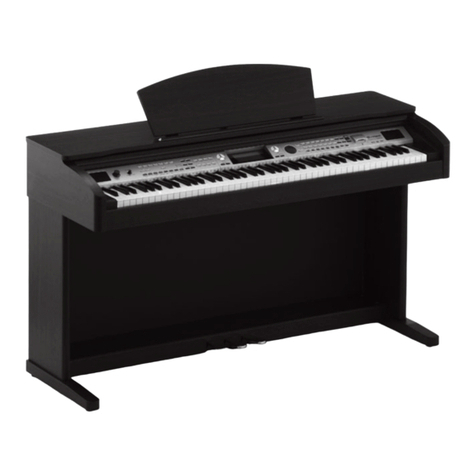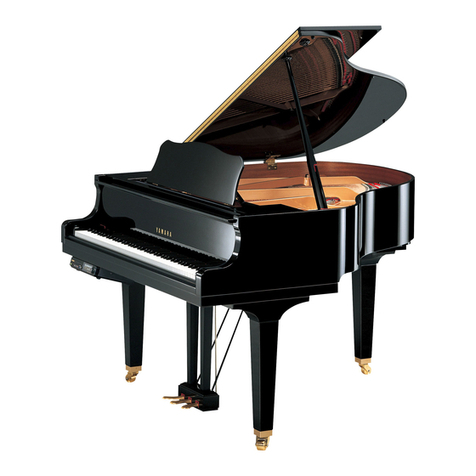StewMac Single-Cut Jr Guitar Kit User manual

Sheet #i-5203 Updated 10/18
Assembly Instructions
Welcome to guitar building! If you’re a first-time builder,
this kit is a great way to start. You’ll have fun and learn a lot.
This simple kit is an excellent entry into electric guitar
assembly. It can be built with basic tools. You’ll learn to cut
the peghead shape, attach the neck, and wire it up. After
you build it, we’ll show you how to set it up to play tip-top.
StewMac
SINGLE-CUT JR GUITAR KIT

stewmac.com
2
Tools and supplies ....................................
Parts list .............................................. 3
Create your peghead shape ........................... 4
Set the neck ........................................... 5
Fretwork ............................................. 6
Assemble your guitar ................................. 8
Wire the electronics ...................................11
Final setup ...........................................12
These are the tools and supplies we recommend for assem-
bling this kit. StewMac item numbers are included where
applicable.
Tools
Electric hand drill
Saw for peghead: band saw, jigsaw, or coping saw
Screwdrivers: Phillips, sizes #1 and #2 (#3000)
Flat blade, size 5.0mm (#3000)
Drill bits: 1/16" (#1710)
5/64" (#1712)
Nut slotting files: .013" width (#0823)
.020" width (#0828)
.035" width (#0832)
Fretting hammer (#4895)
Fret crowning file (#1602 or #4491)
Radius sanding block, 12" radius (#0412)
Swivel handle clamp, total of 2 (#3704)
Straightedge (#3850)
6" Steel rule (#4905)
Nut driver, size 10mm (#5890, or wrench #3691)
Wire stripper, for fine gauge wire (#1606)
Adjustable wrench, 4" size (#1680)
Soldering iron (#0502 or #0515)
No-Chip Countersink (#1695)
Supplies
Wood glue (Titebond original, #0620)
Glue brush (#4167)
3M Scotch-Brite pad (#7445, light duty), or 0000 steel wool
Blue permanent marker
ColorTone Lemon Oil (#3864)
Guitar Finishing Step-By-Step book (#5095)
Tools and supplies
Table of contents

stewmac.com 3
Parts list
Neck
Body
Control cavity cover plate with mounting screws
Pickguard with mounting screws
Truss rod cover with mounting screws
4mm hex wrench for adjusting truss rod
Strap buttons, with cushioned washers and screws
Control knobs (set of 2)
Control pots with mounting hardware (set of 2)
Generic strings for preliminary setup
(Also included: higher quality strings for actual use)
Bridge with posts and bushings
Tuners with bushings, washers, and screws (6)
Hookup wire: 9" and 5" lengths
P-90 pickup with mounting screws and springs
Capacitor
Solder
Output jack with mounting screws
Output cord

stewmac.com
4
You can trace a favorite peghead or come up with a look all
of your own. You’ll be cutting your design from the blank
peghead on the kit’s neck.
Make a template
Sketch out your peghead design on a piece of cardboard
or heavy paper and cut it to shape with scissors. Using a
pencil, trace the shape onto the peghead. Use a light touch
that doesn’t dent or compress the wood which could make
sanding out any unwanted lines difficult. Don’t use ink,
because it leaves permanent stains that can even bleed up
through an opaque guitar finish.
Cut the shape
It’s important that your saw stays square to the face of the
peghead while you cut. If it tilts to an angle, you’ll get a
sloppy result that takes a lot of sanding to correct. Use a
bandsaw if you have one; a jigsaw is also good. A hand-held
coping saw can also be used, but it’s tough to hand-saw
smooth clean curves.
Never cut on the line
Always cut just outside the line, so you can sand to the line
afterward.
Smooth your saw cuts to create your peghead shape using
rasps, files and sandpaper. Don’t rush: rough patches will
disappear into a good final shape if you take your time.
When you’re happy with your peghead shape, sand the cut
edges smooth using 150-grit sandpaper followed by 220-
grit, then 320-grit.
Create your peghead shape

stewmac.com 5
Set the neck
This is a set-neck kit with a mortise and tenon joint, meaning
the heel of the neck (the tenon) is glued securely into the
neck cavity (the mortise).
Do a dry test to check the fit without glue. Press the neck
straight down from the top until seated all the way down
into the mortise and clamp without glue. Use scrap wood as
cauls to prevent denting the back of the body or damaging
the frets with the clamps.
There will be some small gaps and chips around the joint;
this is normal for a production guitar. These will get filled
when you prep for finishing.
Pull the neck straight up out of the mortise and prepare your
glue, clamp, and cauls. Spread the glue generously over the
sides and bottom of the tenon and the bottom of the mor-
tise. Install the neck as you did during the dry test fit. Move
fast because the moisture in the glue will swell the tenon
and make it difficult to fit if you wait too long.
Once the neck is seated, use a damp cloth to remove any
excess glue squeeze out. Use a radius block as a clamping
caul on the fretboard, and a piece of scrap on the back to
prevent denting the wood and clamp tightly. Watch for
additional squeeze out over the next 15 to 30 minutes and
clean it up with a damp cloth.
Let dry overnight.

stewmac.com
6
Fretwork
Run your fingers lightly along the edge of the fretboard
and feel for sharp fret ends. If the fret ends feel sharp where
they meet the edge of the neck, gently sand them back with
320-grit sandpaper using long strokes down the length of
the neck. Use care not to change the bevel of the frets in
the process.
Straighten the neck
Use the 4mm hex wrench to adjust the truss rod. With a
straightedge on the frets, adjust the truss rod until the
straightedge touches all of the fret tops without rocking.
Turn the truss rod nut counterclockwise (viewed from the
peghead end) to loosen the truss rod, allowing the neck to
bow upward. Turning it right tightens the rod, pulling the
neck back.
For more information, see our Trade Secrets article #33 “Don’t
be nervous about adjusting that truss rod!” at stewmac.com.
stewmac.com search: ts33
Seat the frets
The frets come installed, but they need a little work to
achieve the best playability. Use a fretting hammer to make
sure the frets are all seated properly. The more even your fret
tops are, the less leveling work there is to do later.

stewmac.com 7
Color the fret tops with a blue permanent marker to prepare
them for leveling. The blue ink will show your progress: the
frets are level when sanding has removed some of the blue
across all of the fret tops.
Level the frets
Use adhesive backed sandpaper or double-stick tape to
attach 320-grit sandpaper to the 12" radius sanding block.
With this, level the frets using full length strokes down the
fretboard.
Leveling will leave flat tops on the frets. Use a fret crowning
file to restore their rounded shape.
Reapply blue marker to the fret tops. By filing the sides of the
frets, bring in the edges of the flats left over from leveling.
With a rounding motion, keep bringing in these edges until
all that remains of the top is a very thin line. Don’t remove
this line entirely; filing the fret tops would undo your leveling.
Polishing the frets
Using 400 grit, then 600 grit sandpaper wrapped around a
foam block, run up and down the entire length of the fret-
board. Polish the frets by going over each one with extra fine
Scotch-Brite or 0000 steel wool. Follow up by cleaning the
fretboard with ColorTone Lemon Oil or your favorite condi-
tioner. Use care not to get any excess oil on the bare wood.

stewmac.com
8
Assemble your guitar
Assemble your guitar on a soft pad or cardboard to prevent
denting or scratching the instrument.
Install the tuners
Starting with the bottom set of pegholes, lay out the tuners
with a ruler to make sure they are in line with one another.
Mark out the mounting holes with a scribe or transfer punch.
Tuner mounting screws are very delicate. Use a 5/64" drill
bit to make pilot holes for the screws; if these holes are any
smaller you risk shearing off the screw heads. Lubricate the
screw threads by dragging them across soap or wax for
smooth installation.
With the tuners in place, install the screws in the pilot holes
with a #1 Phillips screwdriver. On the tuner string post, add
a washer then the threaded bushing. Tighten with a 10mm
nut driver or wrench.
Install the bridge bushings
Before installing the bridge bushings into the body it's a
good idea to slightly chamfer the holes for the bushings to
prevent chipping the wood. Cut the edge back just larger
than the outside diameter of the knurling.
Note that there is a ground wire access hole connecting the
treble side tailpiece post hole to the control cavity, this is for
the string ground. The 7" ground wire needs to be installed
before the bushing. Strip 1/2" off of both ends and run the
wire through the hole into the cavity leaving the stripped
end to come in contact with the bushing once installed. Bushing hole
before chamfering
Bushing hole
with chamfer
Ground wire
in bushing hole
Install the bushings. Pressing them in with a drill press is the
preferred method but they can also be installed with gentle
hammer taps using a wooden dowel between the bushing
and hammer.

stewmac.com 9
Drill for cover plates and pickguard
Use a sharp point, such as a scribe (#1672), to mark out the
mounting holes for the control cavity and pickguard. Then,
drill pilot holes for the screws using a 1/16" bit stopping at
3/8" deep. Next, center the truss rod cover over the truss rod
cavity and mark it out. Using a 1/16" bit, drill holes 3/16" deep.
Drill for the jack plate
Mark the mounting holes for your jack plate, then drill pilot
holes using the same 1/16" bit and 3/8" depth as above. The
jack will be installed during the wiring process.
Install the strap buttons
Mount the tail strap button, then choose your location for
the remaining strap button. Drill a 3/32" pilot hole, 1/2" deep.
Drill the pickup mounting holes
Drop the pickup with the cover on into the body cavity.
Install the bridge. String up the low and high E strings from
the generic set, to use as a reference.
Line up the strings with the low and high E polepieces of
the pickup as evenly as possible. Mark the locations of the
holes. After you've marked the holes, remove the strings
and pickup. Then drill the holes with a 5/64" bit, 3/8" deep.
Install the pickup.

This page has been intentionally left blank.

stewmac.com 11
Wire the electronics
stewmac.com search: ts186
This kit comes with 9" and 5" lengths of hookup wire for
running connections from the pickup to the control pots
and output jack.
Make a cardboard template that matches the hole pattern
of the controls for proper parts spacing and easy soldering.
There are two differet taper control pots included. 1 A500K
for volume and 1B500K for tone. Peel the wires apart and cut
to length giving yourself a little slack between components.
Strip about 1/8" of the insulation off of the ends of each wire,
twist each end tight then coat them with a little solder; this
is called “tinning”. Tinning the wire ends as well as the lugs
on the switch, pot, and jack will help your solder joints flow
together quicker and cleaner.
Solder up the pots and capacitor following the wiring dia-
gram to the right, then drop it into the control cavity to make
your final connections.
For help with soldering, see our Trade Secrets video #186
“How to get a good clean solder joint!” at stewmac.com.
5414 Golden Age P-90
1800 Wiring Kit for LP or SG Junior
.022μF
capacitor
Ground to bridge
or tremolo claw
VT
500K 250K
Output
jack

stewmac.com
12
Final setup
Adjust the neck
Install the remaining generic strings.
Neck relief refers to adjusting a neck so that it has a very slight
upbow, rather than being perfectly straight. This relief allows
a little more room for string vibration, reducing the chance
of hitting the lower frets and causing fret buzz.
Depending on your playing style, and how perfectly level
your fret tops are, a neck should be anywhere from perfectly
straight to having 0.012" of relief. This measurement refers
to additional string height over the 12th fret, compared to
a perfectly straight neck.
A straight neck tends to play and sound better, but very few
guitars end up with no relief at all, and several thousandths
of an inch or more is perfectly normal.
You can use a straightedge or the low E string to get you in
the ballpark. Using your index finger, hold down the E string
at the first fret. With the other hand, hold down the string at
the 17th fret with your thumb and use your index finger to
check for relief. The smaller the gap between the bottom of
the string and the top of the frets, the straighter the neck.
Lower the nut slots
Once the neck is adjusted to the desired straightness, the
nut slots will need to be lowered for the best playability.
Measure the gap between the bottom of the string and the
top of the 1st fret.
A comfortable medium action over the first fret is .012" for
the plain strings (G,B,E), and .020" for the wound strings
(E,A,D).
Use feeler gauges to measure the gap or use guitar string
scraps whose gauges match the measurement you are shoot-
ing for. Using just a few file strokes at a time, stop filing when
the string sits on the top of your feeler gauge, whatever it
may be. Take your time and check your work frequently. It
is easy to go too far lowering the slots thus ruining the nut.
Turn the truss rod nut
counterclockwise to bring
the neck up, adding relief.
Measure string relief
at the 12th fret.
Turn clockwise to pull the
neck back, reducing relief.
Go slow: a little does a lot!

stewmac.com 13
Set the string height
Adjust the bridge action using a large screwdriver on bass
and treble side adjustment posts. Measure the gaps between
the bottom of the low and high E strings and the top of the
12th fret.
Factory action for the high at the 12th fret is 1/16" for the
high E string, and 5/64" for the low E.
Set the intonation
The last step is intonating the guitar by adjusting the string
lengths at the bridge saddles. This will help ensure that the
guitar plays in tune all the way up the neck.
Remove the generic strings and install the higher quality set.
Tune the strings to pitch using a strobe or other accurate
tuner. Then, press the high E string lightly at the 12th fret
with just enough pressure on the fret to sound the note.
Check it with your tuner.
If the note reads flat, the saddle needs to be adjusted forward
towards the nut, shortening the length of the string. If the
note reads sharp, the saddle needs to be adjusted back away
from the nut, increasing the string length.
Adjust the pickup height
One at a time, hold the low and high E strings down at the
22nd fret.
Adjust the neck pickup to 1/16" between the bottoms of the
low and high E strings and the top of the pole pieces. Adjust
the bridge pickup to 3/32".

This page has been intentionally left blank.

stewmac.com 15
You’re done!
Congratulations!
Your guitar is now ready for finishing. We hope this guitar
will be the first of many that you have fun assembling and
customizing. For detailed information about applying a
great looking finish check out our book Guitar Finishing
Step-By-Step.
Be sure to get a gig bag or case, so it doesn’t get banged
around!

21 N. Shafer St • Athens, Ohio 45701 • USA
USA & Canada call toll-free: 800-848-2273
9am-6pm weekdays Eastern time
stewmac.com
Table of contents
Other StewMac Musical Instrument manuals

